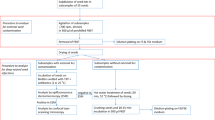Abstract
Oospore production inVicia faba, cv. Metissa, was quantified in the field after plants had been inoculated with a sporangium suspension of a homothallic isolate ofPeronospora viciae f.sp.fabae. Oospores were produced abundantly during the hole growing season from 3 weeks after inoculation on. Oospores were found in all plant parts above soil level, except in the seeds. Most oospores were found in the leaves. Less oospores were formed in leaves inoculated in an older stage than in those inoculated in a younger stage. Towards the end of the season, in August, numbers of oospores in pods strongly increased.
Oospore production in leaves of three cultivars, Metissa, Toret and Maris Bead, was studied in growth chambers at 5, 10, 15 and 20 °C at 16 h light. Oospores were formed earlier at higher temperatures than at lower temperatures. The ultimate numbers of oospores produced in leaves were highest at 10 and 15 °C. Similar numbers of oospores were formed in leaves of cultivars Metissa and Toret. In leaves of cv. Maris Bead significant less oospores were produced than in leaves of cv. Metissa and cv. Toret. Total numbers of oospores produced were not related to the level of host plant resistance to downy mildew. The percentage of asexually sporulating leaf area, assessed in a resistance test, was largest in cv. Metissa and smallest in cv. Toret.
Similar content being viewed by others
References
Allard, C., 1970. Recherches sur la biologie du mildiou du pois. Annales de Phytopathologie 2: 87–115.
Arens, K., 1930. Untersuchungen überPseudoperonospora humuli (Miyabe u. Takah.) den Erreger der neuen Hopfenkrankheit. Phytopathologische Zeitschrift 1: 169–193.
Dickinson, C.H. & Crute, I.R., 1974. The influence of seedling age and development on the infection of lettuce byBremia lactucae. Annals of Applied Biology 76: 49–61.
Dixon, G.R., 1981. Downy mildews on peas and beans. In: D.M. Spencer (Ed.), The downy mildews. Academic Press, London. pp. 487–514.
Glasscock, H.H., 1963. Downy mildew of broad bean. Plant Pathology 12: 91–92.
Inaba, T. & Hino, T., 1980. Influence of water and temperature on oogonium and oospore formation of downy mildew fungus,Peronospora manshurica, in soybean lesions. Annals of the Phytopathological Society Japan 46: 480–486.
Inaba, T. & Hino, T., 1981. Influence of water and humidity on oospore formation of several downy mildew fungi. Annals of the Phytopathological Society Japan 47: 694–696.
Jamoussi, B., 1968. Attaque de mildiou sur fève. Archives de l’Institut Pasteur de Tunis 45: 117–127.
Kittlitz, E. von, Kries, A. von, Meier, U., Stulpnagel, R. & Wittstock, I.M., 1984. Entwicklungsstadien der Fababohne, Biologische Bundesanstalt für Land-und Fortswirtschaft, Merkblatt Nr 27/10 Braunsweig, 11 pp.
Matthews, P., 1981. Breeding for resistance to downy mildews. In: D.M. Spencer (Ed), The downy mildews. Academic Press, London. p. 165–181.
Mence, M.J. & Pegg, G.F., 1971. The biology ofPeronospora viciae on pea: factors affecting the susceptibility of plants to local infection and systemic colonization. Annals of Applied Biology 67: 297–308.
Michelmore, R.W., 1981. Sexual and asexual sporulation in the Downy Mildews. In: D.M. Spencer (Ed.), The downy mildews. Academic Press, London. p. 165–181.
Mukerji, K.G., 1975.Peronospora viciae. Descriptions of pathogenic fungi and bacteria no. 455. Commonwealth Mycological Institute, Kew. UK.
Niks, R.E., 1986. Failure of haustorial development as a factor in slow growth and development ofPuccinia hordei, in partially resistant barley seedlings. Physiological and Molecular Plant Pathology 28: 309–322.
Pegg, G.F. & Mence, M.J. 1970 The biology ofPeronospora viciae on pea: laboratory experiments on the effects of temperature, relative humidity and light on the production, germination and infectivity of sporangia. Annals of Applied Biology 66: 417–428.
Populer, C., 1981. Epidemiology of downy mildews. In: D.M. Spencer (Ed.), The downy mildews. Academic Press, London. p. 57–105.
Ramsey, G.B., 1931. Oospore stage ofPeronospora viciae on peas. Plant Disease Reporter 15: 52–53.
Reiling, T.P., 1984. Downy mildew. In: D.J. Hagedorn (Ed.), Compendium of pea diseases. American Phytopathological Society. p. 19–21.
Sherriff, C. & Lucas, J.A., 1989. Heterothallism and homothallism inPeronospora parasitica. Mycological Research 92: 311–316.
Stegmark, R., 1992. Breeding for partial resistance to downy mildew in peas. Department of Plant Breeding Research. The Swedish University of Agricultural Sciences. Dissertation. 94 pp.
Von Heydendorff, R.C., 1977. Untersuchungen zur Biologie vonPeronospora pisi Syd., dem Erreger des falschen Mehltaus an Erbsen, als Grundlage für die Züchtung resistenter Sorten. Dissertation. 136 pp.
Author information
Authors and Affiliations
Rights and permissions
About this article
Cite this article
van der Gaag, D.J., Frinking, H.D. & Geerds, C.F. Production of oospores by Peronospora viciae f.sp. fabae. Neth. J. Pl. Path. 99 (Suppl 3), 83–91 (1993). https://doi.org/10.1007/BF03041398
Accepted:
Issue Date:
DOI: https://doi.org/10.1007/BF03041398




